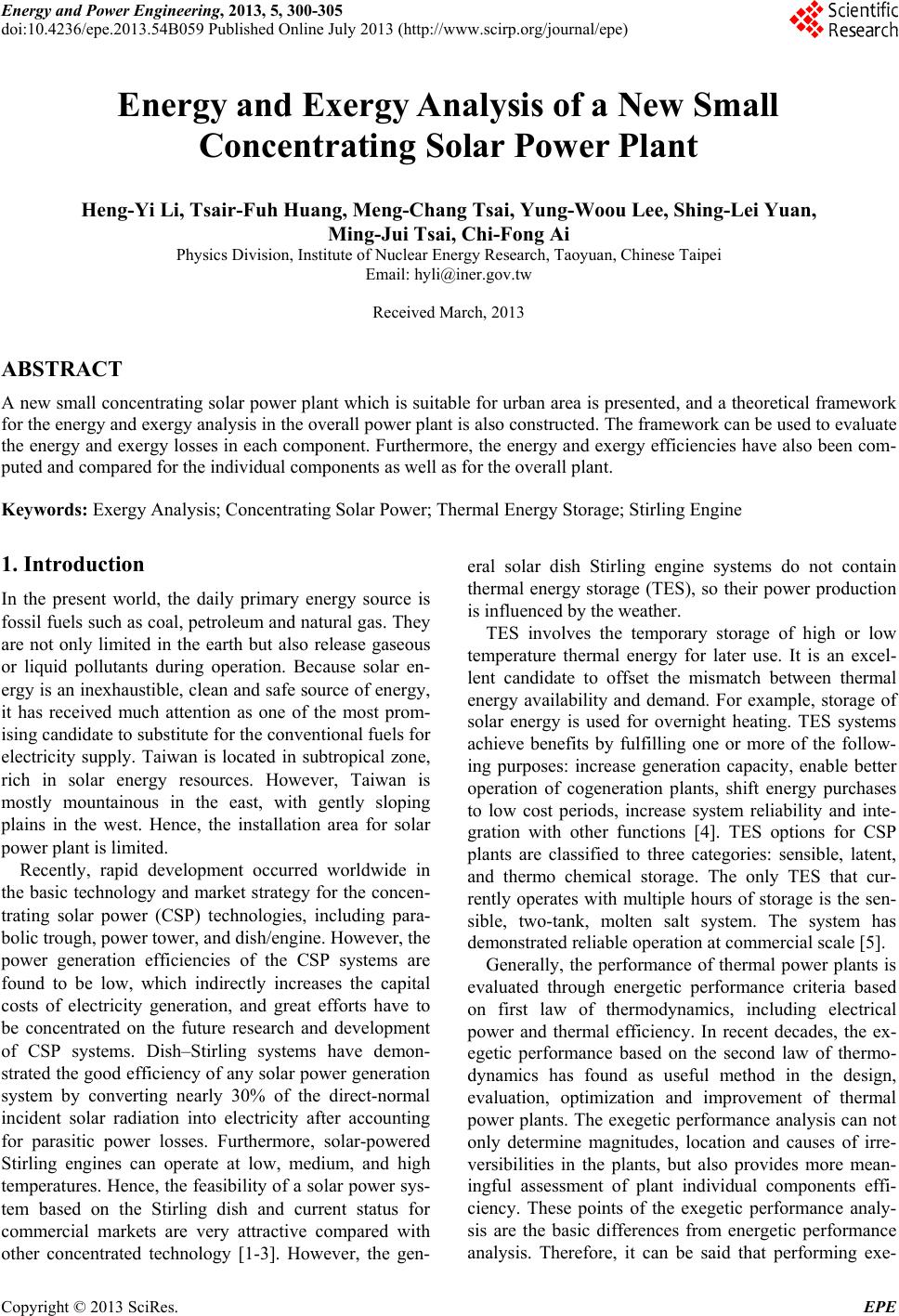
Energy and Power Engineering, 2013, 5, 300-305
doi:10.4236/epe.2013.54B059 Published Online July 2013 (http://www.scirp.org/journal/epe)
Energy and Exergy Analysis of a New Small
Concentr a ti ng Solar Power Plant
Heng-Yi Li, Tsair-Fuh Huang, Meng-Chang Tsai, Yung-Woou Lee, Shing-Lei Yuan,
Ming-Jui Tsai, Chi-Fong Ai
Physics Division, Institute of Nuclear Energy Research, Taoyuan, Chinese Taipei
Email: hyli@iner.gov.tw
Received March, 2013
ABSTRACT
A new small concentrating solar power plant which is suitable for urban area is presented, and a theoretical framework
for the energy and exergy analysis in the overall power plant is also constructed. The framework can be used to evaluate
the energy and exergy losses in each component. Furthermore, the energy and exergy efficiencies have also been com-
puted and compared for the individual components as well as for the overall plant.
Keywords: Exergy Analysis; Concentrating Solar Power; Thermal Energy Storage; Stirling Engine
1. Introduction
In the present world, the daily primary energy source is
fossil fuels such as coal, petroleum and natural gas. They
are not only limited in the earth but also release gaseous
or liquid pollutants during operation. Because solar en-
ergy is an inexhaustible, clean and safe source of energy,
it has received much attention as one of the most prom-
ising candidate to substitute for the conventional fuels for
electricity supply. Taiwan is located in subtropical zone,
rich in solar energy resources. However, Taiwan is
mostly mountainous in the east, with gently sloping
plains in the west. Hence, the installation area for solar
power plant is limited.
Recently, rapid development occurred worldwide in
the basic technology and market strategy for the concen-
trating solar power (CSP) technologies, including para-
bolic trough, power tower, and dish/engine. However, the
power generation efficiencies of the CSP systems are
found to be low, which indirectly increases the capital
costs of electricity generation, and great efforts have to
be concentrated on the future research and development
of CSP systems. Dish–Stirling systems have demon-
strated the good efficiency of any solar power generation
system by converting nearly 30% of the direct-normal
incident solar radiation into electricity after accounting
for parasitic power losses. Furthermore, solar-powered
Stirling engines can operate at low, medium, and high
temperatures. Hence, the feasibility of a solar power sys-
tem based on the Stirling dish and current status for
commercial markets are very attractive compared with
other concentrated technology [1-3]. However, the gen-
eral solar dish Stirling engine systems do not contain
thermal energy storage (TES), so their power production
is influenced by the weather.
TES involves the temporary storage of high or low
temperature thermal energy for later use. It is an excel-
lent candidate to offset the mismatch between thermal
energy availability and demand. For example, storage of
solar energy is used for overnight heating. TES systems
achieve benefits by fulfilling one or more of the follow-
ing purposes: increase generation capacity, enable better
operation of cogeneration plants, shift energy purchases
to low cost periods, increase system reliability and inte-
gration with other functions [4]. TES options for CSP
plants are classified to three categories: sensible, latent,
and thermo chemical storage. The only TES that cur-
rently operates with multiple hours of storage is the sen-
sible, two-tank, molten salt system. The system has
demonstrated reliable operation at commercial scale [5].
Generally, the performance of thermal power plants is
evaluated through energetic performance criteria based
on first law of thermodynamics, including electrical
power and thermal efficiency. In recent decades, the ex-
egetic performance based on the second law of thermo-
dynamics has found as useful method in the design,
evaluation, optimization and improvement of thermal
power plants. The exegetic performance analysis can not
only determine magnitudes, location and causes of irre-
versibilities in the plants, but also provides more mean-
ingful assessment of plant individual components effi-
ciency. These points of the exegetic performance analy-
sis are the basic differences from energetic performance
analysis. Therefore, it can be said that performing exe-
Copyright © 2013 SciRes. EPE